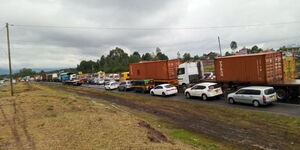The country has been experiencing heavy rainfall for the past month but despite this, water levels at Ndakaini Dam have remained low.
According to various experts, this situation can be attributed to a number of factors and an experienced meteorological officer in Nairobi speculated the dam might have cracks.
“If the catchment area is receiving rainfall and the dam is not keeping water, the only possible explanation is that it has serious cracks and that Nairobi Water officials have poor gauging networks downstream.
"They could have now known what is happening,” he stated.
[caption caption="A section of Ndakaini Dam"] [/caption]
[/caption]
Another theory is that since there have been prolonged dry seasons, the water table sank deeper, thus rainwater takes a longer time to seep through the soil and into small streams (tributaries).
It is also reported that the location of the dam is a factor in the low water levels experienced since it is built on high grounds which have received the least amount of rainfall.
Environmental experts, on the other hand, have attributed the problem to degradation of forest cover in the Aberdares, thus leading to surface run-off.
“If you cannot trace it to either degradation or failed rains, then what is it?” posed Environmental Compliance Institute Executive director Gerry Opondo.
Ndakaini Dam Coordinator Job Kihamba, however, ruled out water vending, saying the dam does not have an outlet.
“There is no outlet that the water can flow out from. Even Nairobi City Water and Sewerage Company has been forced to shut supply from the dam to allow the water levels to rise.
“At the moment, the city is relying on Sasumwa and Ruiru Dams to supply water to Nairobi,” he remarked.
The dam currently has around 23.6 billion litres of water and this means most residential areas in Nairobi will experience reduced water supply.
[caption caption="File Photo"] [/caption]
[/caption]












